Can You Paint Granite Countertops? Yes, You Can!
Author: Rick Worst | Editor: Omar Alonso
Review & Research: Jen Worst & Chris Miller

Can you paint granite countertops? Yes, but before that, you will need to prepare the surface to adhere to the paint. In general, no paint will stick to granite if the surface lacks a good quality primer. Only then you can add paint and sealer to finalize the process.
Many people would be confused about why you need to paint a granite surface. It might not be the first solution, but nothing you can discard either. Adding paint can enhance beauty in many ways, but working on granite surfaces needs precise expertise.
Can you paint over granite countertops? Absolutely! Why and how to do it, let’s find out the answers in the following article.
Why Would You Want to Paint Granite?
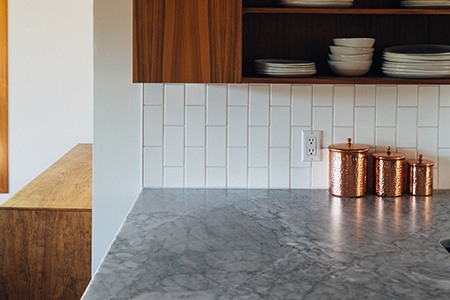
The idea of painting any types of granite countertops might lead others to demoralize you, which in reality seems quite common. No one would want to tamper with their natural granite surface as it is known to have a texture and shimmer of its own.
Those who can afford a quick replacement would go for a new item because repairing or painting granite countertops can be hard work. Why do people paint granite? There are many reasons why some people prefer painting over replacement.
For example, a tabletop can take a hit and wear off in some areas. This is when a simple layer of color can hide the imperfections. Another common thing amongst homeowners is that they get the wrong color combination of the granite countertop corresponding to their kitchen cabinets.
In this case, the whole appearance of your house might turn out to be something that you didn't want. Replacing the old ones with new table tops can be an option, but will cost a hefty amount of money.
Now, if you want to save some cash and are willing to experiment, then painting the countertop can be a decent plan. It might not be the best idea, but at least doable and will exhibit a fresh look.
Keep in mind that you simply cannot start painting a granite plane, it is not meant to adhere to such fluids. There are ways to do it properly, and we will talk about them in our upcoming section.
How to Paint Granite Countertops
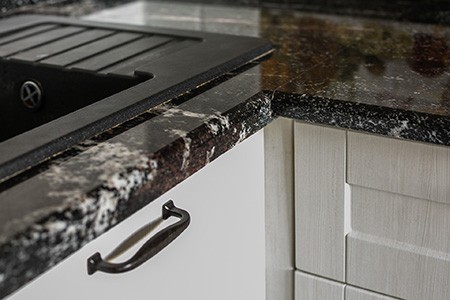
Painting granite countertops is not meant for beginners, it is a meticulous task requiring expert hands for a perfect finish. First, decide why you are painting in the first place. If replacing is a viable option, get it done with something even nicer like some types of marble, if price isn't a problem.
If you are adamant to fix the worn-out or non-matching countertop, then get on with the painting with adequate knowledge. Our experts will discuss how to paint granite countertops successfully to produce a beautiful outcome. Check out the step-by-step guide below.
Step 1: Prepare the Countertop
As we said, granite is already a beautiful material with unique looks, and they are hard to work with, especially when putting paint layers on them. Granite simply won't catch paint, even if it does, it will be temporary. To make it permanent, you need to prepare the granite surface beforehand.
You probably know that granite tables are smooth and shiny and therefore this particular character needs to be stripped off to make the paint sit. You will need a rougher surface to work with, so start by sanding the area you want to paint with any types of sanders. Make sure you do it with patience when scrubbing the smooth layer.
We prefer using a vacuum once you are done, this will ensure that no granite particles or any other debris are left out. Vacuum cleaning will take out the remaining particles and will give you a tidy area to work with. You don't need external elements disturbing the primer or paint.
Note that you must use painter's tape on your nearby cabinets to avoid any kind of unnecessary spill.
Step 2: Apply Primer
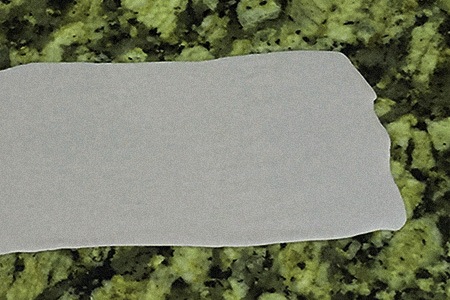
The majority of the surface deserves a priming solution before the paint coatings go on top. Similarly, granite needs to be primed at all costs.
It is the most important step, to begin with. Primers act as the base foundation and sit on the unfinished surface to make it potent enough to embrace top coats.
For preparing a granite countertop you can use types of primer paint like the Giani IronCore Primer (made specifically for granite countertops) or the Kilz Adhesion Primer, these are wonderful products that work with the majority of the surfaces and offer an excellent platform for the main paint.
Such primers are destined to work on glossy layers, so you can be assured about the functionality. Start by soaking the primer on a paint roller and applying it to the granite surface from one end to the other.
Let the solution sit there for 5-10 hours and dry completely. The time will depend on your environment, so it can dry out in an hour or take several hours to be eligible.
Double check whether every bit has been layered with primer solution, if not, you can apply primer and then air dry it before going to the next phase.
Step 3: Select Paint Type
To avoid uneven, splotchy outcomes on granite surfaces, we recommend you to use acrylic paint only. Other types of paint can work too, but nothing will surpass the quality of acrylic paint on granite.
Make sure you have all your preparation ready to apply paint before you put your hands to work, including buying the right paint can sizes so you don't run out. Now talking about the color scheme, it depends on your choice. You can go for bright colors in a smaller area (kitchen/bathroom, etc.). For bigger spaces, the main color can be on the dark end to make things pop out.
Step 4: Painting the Granite
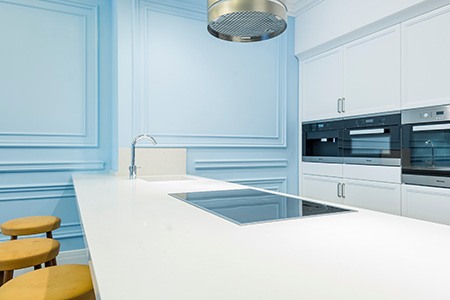
Can you paint granite countertops? Yep, and you're finally about to start. Grab the acrylic paint of your choice and take a sponge along with it. Now start by soaking the sponge with the paint and dab it on the countertop. Why dab and not roll?
Dabbing works for those who want a similar texture or outlook to granite. Keep in mind that rollers will flatten the paint in the sense that it'll fill up all of the pits and divots, whereas a sponge will give you a more organic touch.
One thing to consider though, is if you need the surface to be flat, such as for a kitchen workspace, then you're better off rolling the paint on or using appropriate types of paint brushes for acrylic.
Step 5: Let the Paint Dry
After you have applied the paint, be patient and let it dry for some time. For how long? It will depend on the paint's characteristics, but we recommend you to wait for at least 5 hours. Don't panic if the paint is drying darker or lighter until it's completely dried and cured.
Don't hurry, because, as we already said that granite is very difficult to work with and transform into something new, so chill out and let it dry properly. Check it yourself after 5 hours whether the surface is ready or not.
Step 6: Final Coating of Sealant
You are not done yet. After applying the first layer of paint to the primer and drying it out, you will need a top coat to ensure the paint doesn't flake or chip off. Top coat is what we refer to as sealers here. Take a brush to do the job, and make sure you apply it to parts, including the edges.
Sealers will provide the protective barrier and keep your countertop free from scuffs, scratches, and stains. The best sealer that goes with granite is a masonry sealer. Use a roller to put the solution on the painted surface.
Make sure you don't leave any empty spaces. Use as much sealer as you need, and after that let it dry for about 24 hours. The drying time depends on the sealer you are using. Check the manufacturer label to be sure about it. Once the top part dries out, you can start utilizing the new finish.
Is It Possible to Change the Color of Granite Countertops in Ways Other Than Using Paint?
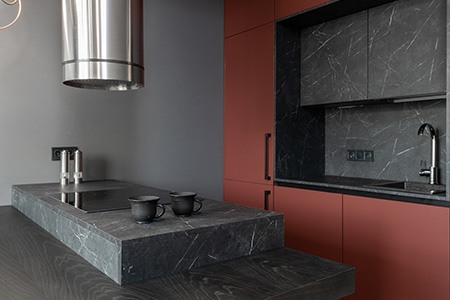
Is it possible to change the color of granite countertops without paint? Frankly, changing the color of granite or faux marble is extremely difficult. If it stains and changes color automatically due to its porous behavior, then that's a different scenario. If you want to change the color of granite, then you will have to soak in some stain to get the desired result.
If you want to avoid painting, then you can work on a light granite and transfer it to a darker shade by using discoloration treatment. You won't be able to go from a darker shade to lighter. This is more like treating an older, worn granite slab and trying to revive it to a darker shade. You can do the following.
Take baby oil on a clean cloth and apply it to the surface you want to darken. If the color change is prominent and you like it, then you can apply a stone color enhancer to seal the deal. That being said, this is not the ideal way to change colors on granite, but it can work in some cases.
Another method you can use is to apply epoxy resin on your countertop to change the appearance in terms of color and texture. This is not a common method of changing color, but it is doable. Epoxy is a bonding glue that is used to repair different stone surfaces, but it can also be used to alter the appearance of granite.
Applying wood stain can also change granite color, but that is a different ball game, and not everybody will want to experiment. Realize, too, that if you use any granite cutting tools after you've painted or stained your granite then you'll end up damaging the new finish and need to repair where you've made cuts.
Can You Paint Granite Countertops? Absolutely
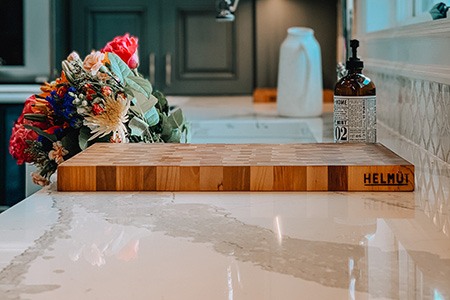
Is it worth painting granite countertops? We don't recommend painting granite because granite itself is a beautifully textured stone. If replacement is on the cards, though, paint it all you want!
You will need to be patient and willing to experiment because the outcome might turn out to be super cool, or it can backfire. If you are looking to save some money by avoiding a replacement and looking for a fix on your old stained granite, then feel free to start painting.
Can you paint granite countertops? Yes, painting granite is possible, but you will have to prepare the surface well enough to adhere paint to it. The process is not as simple as painting a wall or wood. Follow our guide above and you'll be fine!



